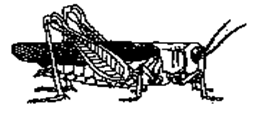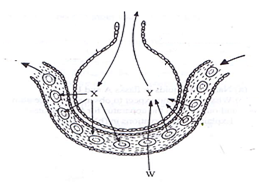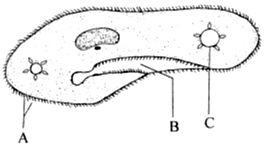Instructions
- Answer all the questions
- You may be penalized for wrong spelling especially technical terms.
- Below is an image of a biological vector. Use it to answer questions that follow.
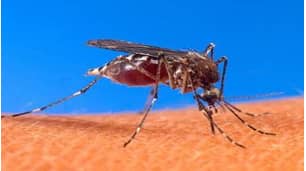
- Identify the parasite transmitted into human blood by the organism. (1 mark)
- Name the blood cells that are destroyed by the parasite in (a) above. (1 mark)
- State one biological method used to eradicate the larvae of this organism. (1 mark)
- Give the structural adaptations of the following in an insect pollinated plant.
- Pollen grain. (1 mark)
- Stigma. (1 mark)
- State the causative agents of the following diseases
- Tuberculosis. (1 mark)
- syphilis (1 mark)
-
- What do you understand by the term ecologically balanced ecosystem? (1mk)
- Give two reasons for loss of energy from one trophic level to another in a food web (2mks)
- Identify the following types of responses:
- Pollen tube growing towards the ovary (1 mark)
- Maggots moving away from light. (1 mark)
- State two activities of the cell that are controlled by the nucleus. (2 marks)
- Distinguish between botany and zoology. (1 mark)
- The field of view of a light microscope appeared as shown below in diagram A and the diameter in A was occupied by cells as shown in B.
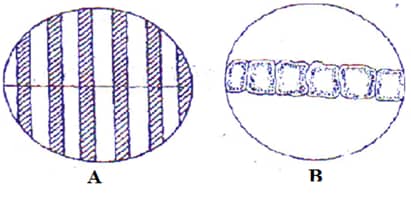
Calculate the length of one cell. (2 marks) - State two importance of water in germination of seeds. (2 marks)
- Why is sexual reproduction advantageous in flowering in plants? (2 marks)
- Below is an illustration of an organism captured by students during a practical lesson.
- Identify two features that enable the organism to be placed in the phylum Arthropoda. (2 marks)
- Explain why the organism will die when Vaseline is applied on its thorax. (1 mark)
- Name two properties of enzyme amylase. (2 marks)
- State the significance of natural selection. (2 marks)
- Explain why a plant shoot develops lateral branches when its tip is removed. (2 marks)
- Why is eating a lot of biscuits harmful to the teeth. (2 marks)
-
- Name the part of the chloroplast where each of the following activities take place.
- Light stage…………………………………………………………………………………..(1mk)
- Dark stage………………………………………………………………………………….(1mk)
- Name two types of cells in a leaf that carry out photosynthesis (2mks)
- Name the part of the chloroplast where each of the following activities take place.
- State any three disorders due to Gene mutation in human beings (3 marks)
- Why is it important that the radicle develops first during germination? (2 marks)
-
- Explain one event of mitosis that restores the genetic constitution of an organism. (1 mark)
- Identify the following types of cell division:
- Division of generative nucleus into male nuclei. (1 mark)
- Division of cells lining the seminiferous tubules. (1 mark)
- State two observable characteristics that show discontinuous variations in Drosophila melanogaster (2 marks)
- Explain why athletes breathe quickly and deeply after a 100 meters sprint. (2 marks)
-
- State two proteins that determine human blood groups. (1 mark)
-
- What is the role of blood capillary? (1 mark)
- Explain why blood does not clot in undamaged blood vessels. (1 mark)
-
- List one type of chromosomal aberrations. (1 mark)
- State one advantage of polyploidy in modern farming. (1mark)
- Explain:
- Why insulin is not administered orally. (1 mark)
- Why stomach wall is lined with mucus (1 mark)
-
- what is homeostasis? (1 mark)
- State two behavioral mechanisms used by snakes to increase their body temperature. (2 marks)
- Explain why only a small amount of food materials taken up by herbivores is passed on to secondary consumers. (2 marks)
- Below is a diagram of a respiratory surface. Use it to answer questions that follow.
- Name the physiological process involved in the exchange of gases in the structure above. (1 mark)
- Identify the substance in cell labeled w that has high affinity for gas X. (1 mark)
- State the advantage of gas Y being transported in cells labeled W (1 mark)
-
- Explain why when transplanting a young plant, it is advisable to remove some leaves. (2 marks)
- Give one role of xylem vessels other than transport (1 mark)
- Study the diagram below and answer the question that follows:
- Name the kingdom from which the organism belongs to. (1 mark)
- State the function of the structure labelled C. (1 mark)
- State two characteristics of a bony fish which enable it to reduce friction in water. (2 marks)
- Identify the structural difference between the wing of a bird and the wing of an insect (1 mark)
- Identify the type of evolution exhibited by the wings of birds and insects and state the name given to such structures. (2 marks)
- Name two characteristics that are controlled by the gene located on:
- Y chromosomes (2mks)
- X chromosomes (2mks)
-
- what is the role of a pollen tube. (1 mark)
- Identify the role of the following hormones in males:
- Follicle stimulating hormone. (1 mark)
- Testosterone. (1 mark)

MARKING SCHEME
- Below is an image of a biological vector. Use it to answer questions that follow.
- Identify the parasite transmitted into human blood by the organism. (1 mark)
- Plasmodium species//Plasmodium vivax//Plasmodium malariae//Plasmodium ovale//Plasmodium falciparum
- Name the blood cells that are destroyed by the parasite in (a) above.(1 mark)
- Red blood cells//Erythrocytes.
- State one biological method used to eradicate the larvae of this organisms. (1 mark)
- Fish feeding on the larvae;
- Identify the parasite transmitted into human blood by the organism. (1 mark)
- Give the structural adaptations of the following in an insect pollinated plant.
- Pollen grain. (1 mark)
- Rough //sticky to stick onto the body of the insect.
- Stigma. (1 mark)
- Occur inside the flower ensuring that the insects brush against them as they look for nectar;// Sticky so that pollen grains from the body of an insect stick onto it; any 1
- Pollen grain. (1 mark)
- State the causative agents of the following diseases
- Tuberculosis. (1 mark)
- Mycobacterium tuberculosis; should be underlined separately.
- Syphilis (1 mark)
- Treponemapallidum; should be underlined separately.
- Tuberculosis. (1 mark)
-
- What do you understand by the term ecologically balanced ecosystem? 1mk
- Equilibrium between living organisms and their environment that ensures survival of all organisms.
- Give two reasons for loss of energy from one trophic level to another in a food web 2mks
- Some energy is lost as heat during respiration
- Excretion
- What do you understand by the term ecologically balanced ecosystem? 1mk
- Identify the following types of responses:
- Pollen tube growing towards the ovary (1 mark)
- Positive Chemotropism;
- Maggots moving away from light. (1 mark)
- Negative Phototaxis;
- Pollen tube growing towards the ovary (1 mark)
- State two activities of the cell that are controlled by the nucleus. (2 marks)
- Cell division;//Growth;//respiation
- Distinguish between botany and zoology. (1 mark)
- Botany is a branch of science that deals with study of plants while zoology is a branch of science that deals with study of animals;
- The field of view of a light microscope appeared as shown below in diagram A and the diameter in A was occupied by cells as shown in B.
Calculate the length of one cell. (2 marks)
Length of one cell = Diameter of field of view in um ;6000 um = 1000um;
Number of cells 6 - State two importance of water in germination of seeds. (2 marks)
- Dissolve food substances//soften testa//hydrolyze food substances//activate enzyme any 2
- Why is sexual reproduction advantageous in flowering in plants? (2 marks)
- Hybrid vigour;
- Causes variations;
- Below is an illustration of an organism captured by students during a practical lesson.
- Identify two features that enable the organism to be placed in the phylum Arthropoda.(2 marks)
- Segmented body;
- Jointed appendages;
- Bilateral symmetry;
- Presence of exoskeleton;
- Explain why the organism will die when Vaseline is applied on its thorax. (1 mark)
- Blocks the spiracles and thus no inhalation;
- Identify two features that enable the organism to be placed in the phylum Arthropoda.(2 marks)
- Name two properties of enzyme amylase. (2 marks)
- Works best under alkaline pH;
- Substrate specific;
- Protein in nature;
- Catalyst;
- Affected by temperatures;
- State the significance of natural selection. (2 marks)
- Formation of new species;
- Elimination of undesirable characteristics;
- Explain why a plant shoot develops lateral branches when its tip is removed. (2 marks)
- Tip has a higher concentration of auxins,when the tip of shoot is removed auxin concentration is lowered; less auxin concentration stimulates sprouting of lateral branches;
- Why is eating a lot of biscuits harmful to the teeth. (2 marks)
- Sugar in biscuits get logged in between teeth, bacteria break down the sugars releasing acids; that corrode the enamel that cause tooth decay;
-
- Name the part of the chloroplast where each of the following activities take place.
- Light stage………… granum
- Dark stage…………..stroma
- Name two types of cells in a leaf that carry out photosynthesis.
- Guard cells
- Palisade cells
- Spongy mesophyll cells.
- Name the part of the chloroplast where each of the following activities take place.
- State any three disorders due to gene mutation in human beings.
- Albinism
- Sickle cell anemia
- Haemophilia
- Colour blindness
- Why is it important that the radicle develops first during germination? (2 marks)
- For absorption of minerals salts and water;
- Anchorage;
-
- Explain one event of mitosis that restores the genetic constitution of an organism. (1 mark)
- Replication of chromosomes during interphase produces doubling chromosomes for sharing out;/ Alignment of spindle at equator during metaphase without association of homologous chromosomes prepares for separation of replicated chromatids;/the separation of chromatids during anaphase will result in same number of chromosomes in daughter cells;
- Identify the following types of cell division:
- Division of generative nucleus into male nuclei. (1 mark)
- Mitosis;
- Division of cells lining the seminiferous tubules. (1 mark)
- Meiosis;
- Division of generative nucleus into male nuclei. (1 mark)
- Explain one event of mitosis that restores the genetic constitution of an organism. (1 mark)
- State two observable characteristics that show discontinuous variations in Drosophila melanogaster (2 marks)
- Wing length;-long dominant over vestigial wing
- Eye colour;-red eyes dominant over white eye.
- Size of abdomen;-broad abdomen dominant over narrow abdomen
- Body colour ;-grey body colour dominant over black body colour
- Explain why athletes breathe quickly and deeply after a 100 meters sprint. (3 marks)
- To increase the supply of oxygen; required to get rid of lactic acid; due to anaerobic respiration;
-
- State two proteins that determine human blood groups. (1 mark)
- Antigen A;/antigen B;/rhesus factor/ all mentioned to get a mark:
-
- What is the role of blood capillary? (1 mark)
- Site for exchange of substances;
- Explain why blood does not clot in undamaged blood vessels. (1 mark)
- Presence of prothrombin in blood//presence of heparin.
- What is the role of blood capillary? (1 mark)
- State two proteins that determine human blood groups. (1 mark)
-
- List one type of chromosomal aberrations. (1 mark)
- Deletion //duplication//inversion//tranlocation//non disjunction// any 1
- State one advantage of polyploidy in modern farming. (1mark)
- Increased yields//early maturity//resistance to drought,pests and disease//any 1
- List one type of chromosomal aberrations. (1 mark)
- Explain:
- Why insulin is not administered orally. (1 mark)
- Insulin is a hormone that is transmitted through blood;
- Why stomach wall is lined with mucus (1 mark)
- To prevent autodigestion;
- Why insulin is not administered orally. (1 mark)
-
- what is homeostasis? (1 mark)
- Self adjusting mechanism that maintains a steady internal state in organisms;
- State two behavioral mechanisms used by snakes to increase their body temperature. (2 marks)
- Coiling;
- Basking;
- what is homeostasis? (1 mark)
- Explain why only a small amount of food materials taken up by herbivores is passed on to secondary consumers. (2 marks)
- Absorbed food is used in cell metabolism;
- Lost in excretion;
- Below is a diagram of a respiratory surface. Use it to answer questions that follow.
- Name the physiological process involved in the exchange of gases in the structure above. (1 mark)
- Diffusion;
- Identify the substance in cell labeled w that has high affinity for gas X. (1 mark)
- Haemoglobin;
- State the advantage of gas Y being transported in cells labeled W(1 mark)
- Does not affect the pH of blood;
- Efficient in loading and offloading of oxygen;
- Name the physiological process involved in the exchange of gases in the structure above. (1 mark)
-
- Explain why when transplanting a young plant, it is advisable to remove some leaves. (2 marks)
- Reduce the surface area/number of stomata exposed to envinronmental factors; thus lower the rate of transpiration;
- Give one role of xylem vessels other than transport(1 mark)
- Mechanical support;
- Explain why when transplanting a young plant, it is advisable to remove some leaves. (2 marks)
-
- Protoctista; Rej– Starting with a small letter(i.e. protoctista Wrong spelling
- Osmoregulation;
- State two characteristics of a bony fish which enable it to reduce friction in water. (2 marks)
- Streamlined body;
- inflexible head;
- scales overlap and are pointed backwards;
- mucus covering the body;
-
- Identify the structural difference between the wing of a bird and the wing of an insect (1 mark)
Wing of a bird Wing of an insect originates from the endoskeleton originates from the exoskeleton; Has bones No bones;any 1 - Identify the type of evolution exhibited by the wings of birds and insects and state the name given to such structures. (2 marks)
- Convergent evolution; analogous structures;
- Identify the structural difference between the wing of a bird and the wing of an insect (1 mark)
-
- Name two characteristics that are controlled by genes located on
- Y chromosomes
- premature baldness
- Tuft hair in ear pinna and nose
- X chromosomes
- Colour blindness
- haemophilia 2mks
- Y chromosomes
- How is the rib adapted for its function? 2mks
- It is long and curved to increase surface area for muscle
- Has tuberutum and captulum / projections for articulation with thoracic vertebrae;
- * Curved to form a ribcage
- Name two characteristics that are controlled by genes located on
-
- what is the role of a pollen tube. (1 mark)
- Facilitates transfer of male nuclei to the embryo sac;
- Identify the role of the following hormones in males:
- Follicle stimulating hormone. (1 mark)
- Synthesis of sperms;
- Testosterone. (1 mark)
- Development of secondary sexual characteristics in males/production and maturation of sperms;
any 1
- Development of secondary sexual characteristics in males/production and maturation of sperms;
- Follicle stimulating hormone. (1 mark)
- what is the role of a pollen tube. (1 mark)
Join our whatsapp group for latest updates
Tap Here to Download for 50/-
Get on WhatsApp for 50/-
Download Biology Paper 1 Questions and Answers - Bungoma Diocese Mock Exams 2021/2022.
Tap Here to Download for 50/-
Get on WhatsApp for 50/-
Why download?
- ✔ To read offline at any time.
- ✔ To Print at your convenience
- ✔ Share Easily with Friends / Students

